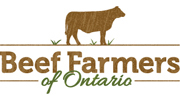DNA Tests for Feed Efficiency and Beef Tenderness
| Project Code: | 0008-023 |
| Completed: | March 2013 |
Project Title:
Researchers:
Dr. Stephen Moore/Dr. Graham Plastow & Dr. Stephen Miller graham.plastow@ualberta.ca
Stephen Moore, PhD, Graham Plastow, PhD, Zhiquan Wang, PhD, Paul Stothard, PhD (University of Alberta), Stephen Miller, PhD, Jim Squires, PhD, Kendall Swanson, PhD, Ira Mandell, PhD (University of Guelph)
- Genome-wide association analyses for carcass quality in crossbred beef cattle
- Impact of reference population on accuracy of imputation from 6K to 50K single nucleotide polymorphism chips in purebred and crossbreed beef cattle.
- Single nucleotide polymorphisms for feed efficiency and performance in crossbred beef cattle
The beef industry would benefit greatly from both reduced feed costs and increased beef quality. Feed efficiency is the most economically important trait in feedlot production, and winter feed costs can account for over 75% of cow-calf production costs. Among female consumers, overall satisfaction with beef is determined more by tenderness than by flavour or juiciness. Although both feed efficiency and tenderness are influenced by genetics, they are very difficult and costly to evaluate in breeding programs. This has made it difficult to improve either of these traits using traditional approaches to seedstock selection. A DNA test that can accurately identify cattle with superior genetics for feed efficiency or tenderness would help to overcome these challenges.
This research project brought together two important resources. First, these researchers were part of a global team that determined the DNA sequence of the bovine genome. That effort uncovered 50,000 DNA markers called single nucleotide polymorphisms (SNPs). Second, University of Alberta and University of Guelph breeding herds have been evaluated for feed efficiency and beef quality for a number of years. This project screened both herds using the 50,000 SNP markers discovered in the Bovine Genome project to see whether any of the DNA markers were more common in efficient (or more tender carcass) cattle than inefficient (or tough carcass) cattle.
Objectives:Identify a panel of DNA markers that will identify genetic differences in feed efficiency and tenderness among beef cattle.
What They Did:The approach to developing a genomic test for feed efficiency had two parts. The first involved a candidate gene approach – looking for SNPs that are closely linked to or are the mutation that causes a fundamental biological change. The next step used data from 2,000 cattle from the University of Guelph and University of Alberta herds that had both 50,000 SNP genotypes and feed efficiency measurements. Advanced statistical techniques were used to combine all of the 50,000 individual marker scores into a genomic prediction for feed efficiency. The genomic prediction was then validated in an unrelated cattle population at Lacombe, Alberta that had feed efficiency measurements.
Tenderness: The 50,000 DNA markers were tested on more than 1,000 crossbred animals from the University of Guelph herd that had tenderness measurements (Warner-Bratzler shear force) collected at slaughter. Each of the 50,000 marker scores and tenderness measurements for each animal were combined into genomic prediction for beef tenderness. The genomic prediction model was then validated on cattle that had been purchased from commercial herds, slaughtered, and measured for Warner-Bratzler shear force. These commercial animals were somewhat related to those cattle in the University of Guelph population used to develop the prediction.
What They Learned:Feed Efficiency: The candidate gene approach identified at least 35 biological mechanisms affecting feed efficiency. These mechanisms were mostly related to ion and cation transport and protein metabolism, and almost certainly affect many other biological functions. This indicates that feed efficiency is a very genetically complex trait. A total of 98 SNPs were significantly associated with feed efficiency, and these explained 16% of the genetic variation in residual feed intake (RFI). This low accuracy underscores the genetic complexity of feed efficiency. Dry matter intake had the highest accuracy of prediction at 36%, and average daily gain the lowest at 15%.
When the genomic prediction for RFI was validated on the independent Lacombe population, the accuracy fell to between 8% (yearlings) and 14% (feeder calves). The lower accuracy in the yearlings is likely a result of low animal numbers in that population, or perhaps biological differences between bulls and steers.
Tenderness: A total of 25 SNPs were significantly associated with tenderness at different times (7, 14, and 21 days of post-mortem aging). The genomic prediction equation based on these markers explained about 36% of the genetic variation in tenderness. Like feed efficiency, the accuracy of this prediction would likely be lower if it was tested in an unrelated population.
What It Means:The results from this project underscore the necessity of validation when developing genomic predictions. Genomic predictions are most accurate when used in the populations they were first developed in. Genomic predictions are less accurate when they are used in unrelated populations. For example, a prediction developed in Angus cattle won’t work as well in Herefords, and vice versa. This is why it can be quite difficult to develop accurate genomic predictions for crossbred cattle, or for sorting commercial feeder cattle. Rapid advances in genomic technology and the identification of candidate genes that influence the trait may help overcome this problem. This project has provided valuable information to other research efforts to improve the accuracy and value of genomic predictions for traits of economic relevance to Canada’s beef industry.












